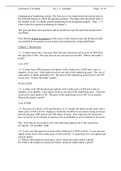Other
Derivatives Test Bank by Dr. J. A. Schnabel (Questions & Answers)
- Course
- E-commerce (DERIVATIVES)
- Institution
- Humber College ( )
Questions from Chapter 1 to Chapter 15 - The quiz and final exam questions will be similar are style the questions found in this Test Bank. Explanation of numbering system: The first one or two digits before the period refer to the textbook chapter to which the question pertains. The digits afte...
[Show more]



